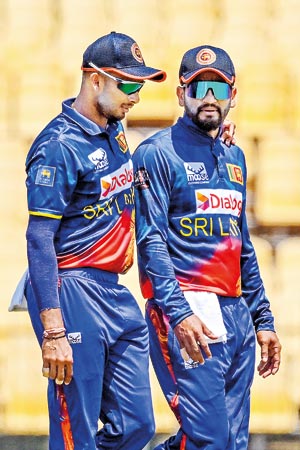Can Sri Lanka emulate epic in Zimbabwe at top stage?

Skipper Dasun Shanaka's recent form has been questioned by many, with two top multi-team events ahead
Now that Sri Lanka has cleared the first hurdle and booked its flight to India, where the game’s biggest spectacle will take place in October, Dasun Shanaka faces a daunting task in leading his charges. On paper, Sri Lanka looks like a team at the peak of its power after winning the qualifiers in Zimbabwe. In reality, the prospects of Sri Lanka dominating the World Cup are slim.
Yes, Sri Lanka were the undefeated champions of the 10-team tournament and held all the aces to beat their weak oppositions but tougher tests await Shanaka’s men at the Asia Cup and World Cup in the coming months.
Amid the usual batting collapses during the tournament, there were some outstanding performances from Pathum Nissanka and Dimuth Karunaratne, the two openers. After being sidelined for more than two years, Karunaratne came back with flying colours and provided the stability that was missing from the batting order for a long time. He didn’t have an explosive approach but his slow and steady style gave Sri Lanka the opportunity to lay a solid foundation.
His recall to the side was met with mixed feelings: while many former players argued for him to be included in the team, many on social media contended that his batting style did not fit today’s fast-paced game. This proved otherwise as Sri Lanka found a man with a solid technique to steer the innings. He ended up as the third-highest scorer of the tournament, despite missing the final against the Netherlands with a minor hamstring strain.
Nissanka has been exceptional at the top, scoring 417 runs in eight matches, including two centuries, to become the second-highest scorer of the tournament. Even though Dhananjaya de Silva, Charith Asalanka, Sadeera Samarawickrema and Kusal Mendis are beginning to assert themselves, the lack of consistency contributed to regular batting collapses as Sri Lanka failed in many instances to capitalise on their solid base upfront.
Three times in the tournament, Sri Lanka was bowled out by their opponents for less than 250 runs, a cause for concern, but their bowling was good enough to crush the opposition. While Sri Lanka’s ability to bounce back from such collapses worked in the qualifiers, the same cannot be expected at the World Cup–a tournament that features the Top 10 teams in the world. It is crucial for Sri Lanka to address this issue and find solutions to prevent such collapses in high pressure games. Of particular concern is the form of Dasun Shanaka, the skipper. He has gone through five innings without a score of any substance.
The right-handed aggressive batter seems to have failed to find the right balance between aggression and caution. He has been attempting too many big shots and getting out, as a result. And he hasn’t been able to rotate the strike as effectively as he used to. Can Shanaka lead the team without contributing with the bat, is a question asked given his current dip in form. Former Sri Lanka T20 captain and once the most feared white-ball seamer in world cricket, Lasith Malinga has backed Shanaka’s captaincy for a long time but he is now questioning Shanaka’s presence in the team without contributing with the bat. Commentator and former Sri Lanka batter, Russell Arnold had similar sentiments.
But for Sri Lanka to make an impact at the Asia Cup and the World Cup, they need him to get out of the current rut as early as possible. During the World Cup in 2014, Sri Lanka had to drop then-captain Dinesh Chandimal over lack of form and he was watching it from the dugout when they laid their hands on the T20 title that year.
A similar fate may await Shanaka and only he can change his destiny. Wanindu Hasaranga, Maheesh Theekshana, Dilshan Madushanka, and Lahiru Kumara have regularly grabbed the headlines by overrunning batters and emphatically helping the team on their way to qualification. But it must be remembered that these victories were against weaker opponents placed lower in the ICC rankings.
While Hasaranga came up trumps in early stages with three five-wicket hauls, Theekshana made his mark in the second half of the tournament. They shared 43 wickets to become the top two highest-ranked bowlers in the tournament. This was to be expected as many batters of associate teams found it difficult to read them given their limited exposure to them.
But such luxury cannot be enjoyed during the World Cup. Hasaranga led the bowling charts with 28 wickets since the Afghanistan series. His previous 10 innings, however, had fetched him only 10 wickets. He also had five consecutive games without a wicket. One can only hope and pray that Hasaranga will bowl against top-tier teams with the same tenacity as he did in Zimbabwe.
Seamers have been exceptional, barring Dushmantha Chameera, who missed the tournament due to pectoral muscle pain. In his absence, Lahiru Kumara and Dilshan Madushanka showed up and this is an encouraging sign. Overall, the position of Sri Lanka is not as promising as one would like it to be. They will have to work extra hard to improve their skills to face the top teams. If they do, as Chief Selector Pramodya Wickremasinghe expects, Sri Lanka may get into the last four. If not, a first-round exit is unavoidable.


